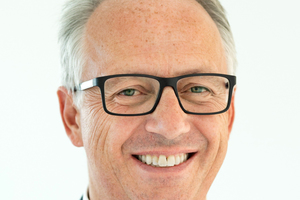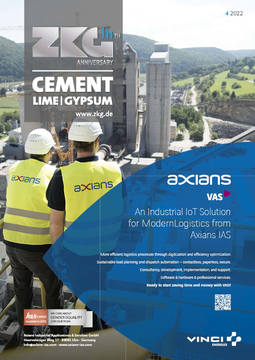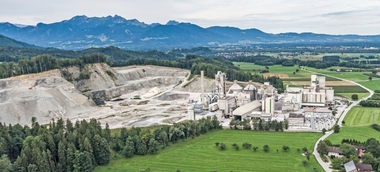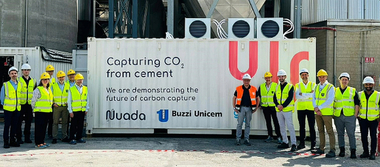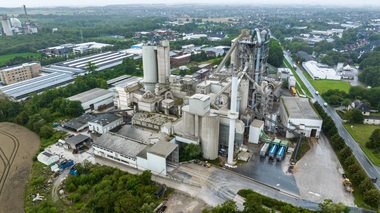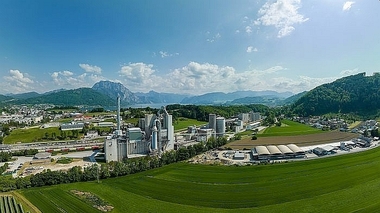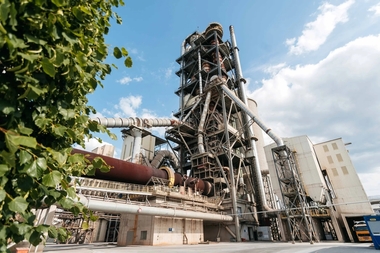The pioneering role has a long tradition
ZKG Cement Lime Gypsum took the construction of Germany’s first CO2 capture plant for cement production as an opportunity to take a closer look. Dr. Helmut Leibinger, Head of Plant and Process Engineering at Rohrdorfer, met with Dr. Petra Strunk, Editor-in-Chief of ZKG Cement Lime Gypsum, for a discussion.
What was the background to the construction of the separation plant – the first in a German cement plant?
I have been working at the cement plant in Rohrdorf since 2006 and am responsible for plant engineering. The topic of CO2 has occupied me for more than 15 years. In recent years, the topic has become more and more present.
The cement plants in the north have an easier time in the direction of CCS. The storage facilities in Norway, e.g. Northern Light etc., offer to inject CO2. In this respect, we have a location disadvantage here in Rohrdorf, as we have no loading ports here, i.e. we cannot transport our CO2 away. That is the first problem. There is also no CO2 pipeline heading north. That’s why the logical step for us is to utilize the CO2 in a different way. Especially when the demand from the chemical industry for carbon is there. We have received a direct offer from this sector – in this respect, processing the CO2 directly at the cement plant makes sense for us. You have to consider that there are about 250 kg of carbon in 1 t of CO2, carbon is currently still mainly used from fossil sources. Supply and demand are there, the business model is right. And it has to pay off. We still have to work out the cost side, what does methanol synthesis cost, for example, and so on.
What is the basic principle, what is the challenge in CO2 capture in a cement plant?
The CO2 exits the prewash with 40 °C and then enters the actual amine wash. In the amine wash, the amine is injected at the top via a column tower, it trickles down the tower and absorbs the CO2 in the process, and it is then drawn off at the bottom in the pump sump. The loaded wash solution then goes into a desorber and under temperature and pressure the CO2 is released back from the amine. The clean amine goes back into the amine scrubber and the CO2 goes out the top via the dome. The efficiency of the scrubbing is between 90 and 95 %. The CO2 gas still needs to be purified as it contains residues of water and oxygen. Roughly, the process can be divided into three steps: Pre-cleaning, absorption and desorption.
Compared with CO2 capture in coal-fired power plants, the gas in our case contains a higher proportion of oxygen. Therefore, the main question is how high is the oxygen content, i.e. how much oxygen goes along. Because of the increased corrosion that then occurs, this is a problem both for the storage variant and for further use. This challenge has to be solved especially for CO2 capture in cement plants.
The CO2 gas is then further processed into organic basic building blocks, do you give this to a chemical company or does this take place at Rohrdorfer itself?
Rohrdorfer does that itself. This is a pure Rohrdorfer project. In total, 18 employees at Rohrdorfer deal with the topic of CO2, and some of these employees deal exclusively with the topic of CCU. We simply want to make progress in this area as well, without writing long applications or studies. We want to get started, build the plant and learn how to operate it efficiently.
How did Rohrdorfer get involved with the topic? Around 2020, the chemical industry approached us and asked if they could have our CO2. The chemical industry has the problem when coal and natural gas cease to exist, they need another carbon source. With our CO2, we have a very interesting source. Then, of course, there was the question of the purity of the CO2. The chemical industry needs the CO2 for methanol synthesis and for this they need a very pure CO2. So we built a pilot plant to know how clean is our CO2 in the end. And also with the background that the previous capture plants were mainly built behind coal boilers, this CO2 has a different composition than in a cement plant. For us, the question was then where to put the CO2 – the chemical industry would rather have a product than the CO2 gas. We then started to look at the possibilities of synthesizing a product, which could be ethylene, methanol, formic acid or even e-fuels. The first step is the way via formic acid as a very simple organic compound and one needs the least hydrogen for it. We will electrochemically produce the hydrogen in situ in the water-CO2 mixture, and the O2 produced as a byproduct can be used for the oxyfuel process.
An interesting project – a cement plant becomes a chemical plant. Why is Rohrdorfer the first cement plant to take this path and how economical is this path? Or is idealism more to the fore in this project?
In order to use the process economically, we have to work on efficiency, and the process only makes sense if we use renewable energy. The existing capture processes are optimized for Carbon Capture and Storage and not for Carbon Capture and Usage. That’s why we built this pilot plant for CO2 capture and formic acid production. Our goal was to then optimize these two coupled processes. So we looked at optimizing both the amine solutions and the wash solutions. The ecological footprint was also important to us.
Our goal is not to capture as much CO2 as possible, but to have a plant on which we can modify and try out a lot without too much effort. At the end of the day, the result must be a product that is competitive.
At Rohrdorfer, we have a certain tradition of building and testing pioneering pilot plants. We had the first pilot plant with a clean gas catalyst. We have a power plant that generates electricity from kiln waste heat, and there was also a pilot plant beforehand. It is already a tradition at Rohrdorfer, so to speak, that we simply build these pilot plants and see whether it works. The concept has always proven itself so far, also financially. In the meantime, we have also taken on a pioneering role.
What are the future plans for CO2 capture?
The plant is scheduled to go on stream at the end of June 2022. Formic acid production will then go on stream in the summer, as a second step. And of course we also have to get our employees up to speed on the operation of this new plant.
The whole thing has to be seen in an overarching context, we also need the appropriate connection to the power grid, we need an appropriate hydrogen infrastructure. To do this, we need the appropriate governmental framework.
We can scale up our pilot plant. The next task is to determine what infrastructure is needed for further expansion. Our pilot plant should then be transferable to other cement plants, but also to other industries. The industry has already gathered momentum. But policymakers must first do their homework. Because only together – industry, politics and the population – can we solve the decarbonization task of the century.
Thank you very much for the very interesting interview.

